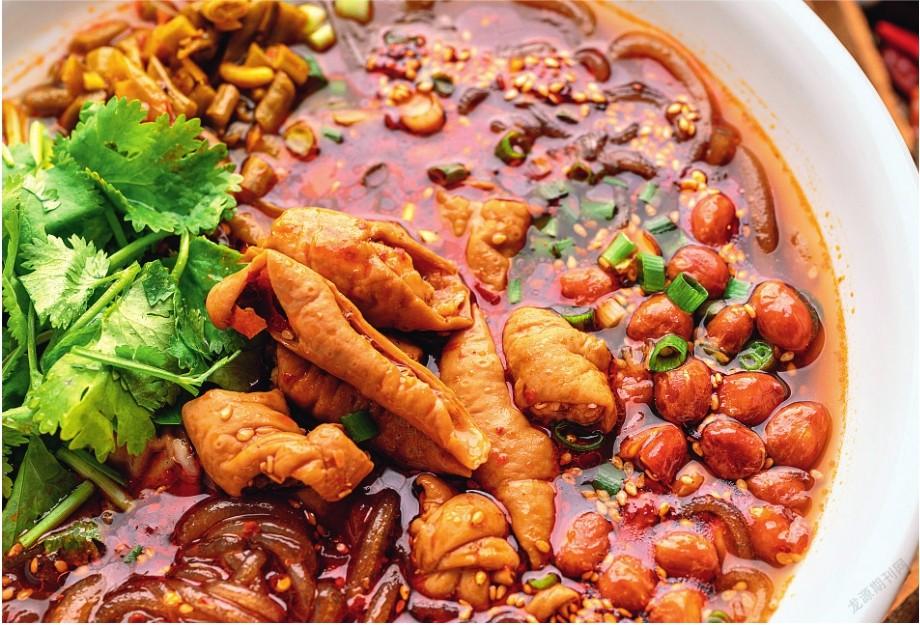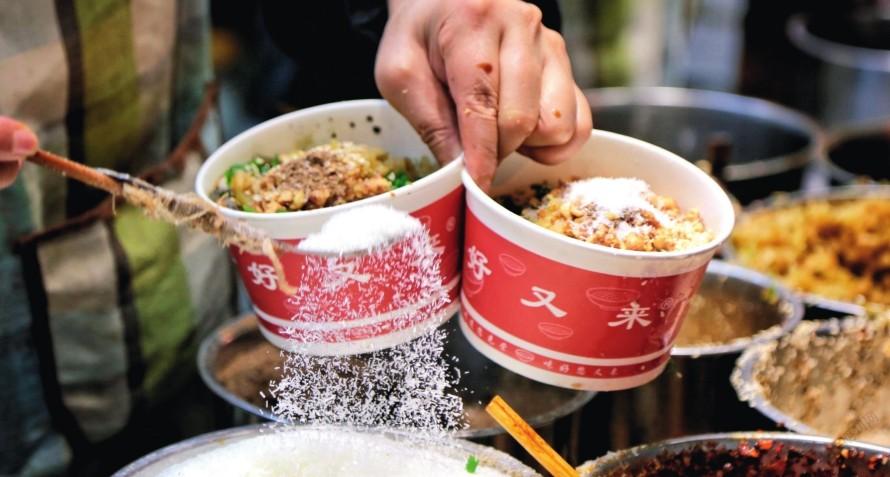酸辣粉“嗦”出的成渝味
2020-09-10高维微
高维微
不知从何时起,“嗦粉”突然成了热词、趣事,江西、湖南、贵州、广西,全国各地的“嗦粉”爱好者纷纷晒出自己心目中的“粉界花魁”,一时间天南地北各种口味的粉搅动着味道江湖。相对于螺蛳粉这类“网红粉”,成渝地区的这碗“粉”显然资格更老、名气更大。
与大多数地方“粉”所指代的米粉不同,成渝地区食客口中的“粉”,多指用红薯粉制成的酸辣粉。
好吃的酸辣粉,有一种如炖猪蹄般的软糯口感,又酸又辣的滋味总是让人欲罢不能,一口嗦下去,滑溜溜的,胶原蛋白口感的粉会“哧溜”一下滑入口中。
嗦完粉,食客们还会伸出舌头,将吸附在唇上的汁水舔掉。对于有经验的老饕来说,这一舔至关重要,照他们的说法,酸与辣融合得好不好,味道全在唇上沾的那点汁水里。
The phrase "slurping rice noodles" crept in at some point and suddenly became a hot word. Keen fans of rice noodles from Jiangxi, Hunan, Guizhou, Guangxi, and all over the country then rush to share the"best rice noodles" in their mind. For a split second, rice noodles of various flavors from both the south and the north have got a change to flourish. Compared with the "network celebrities" such as Liuzhou river snails rice noodle, the rice noodles in Chengdu and Chongqing enjoy more prominent reputation and popularity.
Unlike rice noodles in most places, people in Chengdu and Chongqing refer to the hot and sour rice noodles made of sweet potato flour when they talk about rice noodles.
The delicious hot and sour rice noodles tastes softly and glutinously, just like stewed pig’s trotters. The sour and spicy taste of rice noodles is irresistible to all. Slurping a mouthful of the slippery, collagen-tasting rice noodles, you will feel it slide into your mouth at one stroke.
Finishing eating, diners will stick their tongues out and lick off the juice on their lips. For experienced gourmets, the last lick is very important. In their words, they can judge whether the acid and spicy mix well or not from the juice on the lip.
要吃一碗正宗的酸辣粉,自然得是手工制作的红薯粉,最好是现场制作的。
更讲究一些的店家,还会用高汤做底。当滚烫的高汤和佐料相逢,空气中立马弥漫开一种独特的酸辣香味。

如果說佐料是酸辣粉的灵魂,那盖在酸辣粉上的浇头,则是承载这抹灵魂的肉体。
A bowl of authentic hot and sour rice noodles must be handmade from sweet potato powder, preferably made on site.
Some experienced restaurant owners may use stock as the base. When the hot stock meets the ingredients, a unique sour and spicy fragrance will immediately float in the air.
If the condiments are the soul of the hot and sour rice noodles, then the topping covering the rice noodles will be the body carrying the soul.
成都人最钟爱肥肠浇头,成都青石桥街可以说是肥肠粉的“大本营”,每家的味道各有千秋。老瓦房肥肠粉、复兴肥肠粉,算得上这条街乃至成都肥肠粉里的“扛把子”。
说到成都的肥肠粉,就不得不说“冒节子”。冒节子,就是有一段在红油里“冒”(烫)过的猪小肠。在成都,吃肥肠粉不加冒节子,就跟麻婆豆腐不撒花椒面一样。它被成都人称为只要两块钱就能提升整碗肥肠粉境界的灵魂食物。饕客在咬破冒节子前,还会先选个下口的地方,以防止肥肠里的汤汁洒出。
不过,各家的冒节子总是有些区别。稳健派,会用棉线把小肠的两端捆好;省事派,一般会把小肠两头合在一起打个死结;精致派,会在小肠中间打一个简约版的中国结……
成都人卖肥肠粉,卖的并非那一碗红薯粉。精明的店家很讲究搭配些辅食,比如军屯锅盔。也不知是谁说的,吃肥肠粉就得搭军屯锅盔,就像吃火锅必点毛肚,酸辣粉的软糯和锅盔的酥脆搭配着吃堪称绝配。
Chengdu people prefer hot and sour rice noodles with the topping of pig’s large intestines. The Qingshiqiao Street in Chengdu is home to many pig’s intestines rice noodles restaurants, each has its own unique flavor. Laowafang Pig’s Intestines Rice Noodles and Pig’s Intestines Rice Noodles are the two most welcomed rice noodles restaurants in this street and even Chengdu.
When it comes to pig’s intestines rice noodles in Chengdu, we have to mention"Maojiezi". Maojiezi refers to a section of small intestine of pig that has been"steamed" (scalded) in red oil. In Chengdu, eating pig’s intestines rice noodles without adding Maojiezi is just like eating mapo tofu without sprinkling pepper. It is a soul food that Chengdu people believe can improve the entire bowl of rice noodles at a cost of only two yuan. Gourmets will choose a point to get start before biting Maojiezi to prevent the soup in it from spilling out.
However, Maojiezi made in each restaurant varies. The conservative group often use cotton thread to tie the two ends of the small intestine; Convenience seekers usually put the two ends of the small intestine together to form a fast knot; While perfectionists often make a simple version of Chinese knot in the middle of the small intestine...
Rice noodles restaurants in Chengdu sell not only the sweet potato powder. Smart store owners pay much attention to some complementary foods, such as Juntun Guokui. Someone even said that Juntun Guokui is a perfect match to pig’s intestines rice noodles, just like hot pot and tripes. The soft, glutinous hot and sour rice noodles pair up quite nicely with the crisp Guokui.

在重慶吃酸辣粉,讲究就相对要少些,酸辣粉的浇头大多与小面共用,以炸酱为主,间或也有牛肉和肥肠。粉丝出锅,老板会在粉上盖一层厚厚的、油亮亮的炸酱。北碚金华路上一家早餐店的酸辣粉更为霸气,浇头是巴掌大、约1厘米厚的牛肉,老板振振有词地解释:“吃肉就是要吃安逸。”
不过,在重庆要论名气,还要数八一路好又来的炸酱酸辣粉更响亮,这一点只要走到八一路看看排队的食客就一目了然。店铺开张以来,这里的酸辣粉就只有两种,“加炸酱的”和“不加炸酱的”。店里一口电饭锅里,装的就是保着温的炸酱。选择虽少,但不影响店铺前排队的队伍长度,这其中不乏很多逛解放碑的本地人。坐在花坛边的休息凳上,或者干脆站在街边,端着纸碗小心翼翼有滋有味地“嗦”一碗油汪汪的酸辣粉,这样的场面,曾一度是熙熙攘攘的八一路的标配。
酸辣粉的来历,似乎并没有确切的说法。流传最广的,是三国时期刘关张桃园结义的故事。寓意虽然美好,不过,红薯和辣椒都是在明朝才传入中国,而辣椒一开始还只是作为一种观赏作物。
随着红薯在成渝地区大面积种植,劳动人民或许是借鉴了粉丝的制作方法,制作出了红薯粉。在物质匮乏的年代,一碗口感软糯的酸辣粉,被当做肉食替代品而广受欢迎。
如今,酸辣粉已经成为地方特色美食之一,不少旅游景区都能看到酸辣粉的身影:做酸辣粉的师傅,一手端着篦子,一手在篦子里的粉坨上匀速拍打,一根根粉条便从几十个孔洞中漏出,落入沸腾的大锅里。粉条烫熟后,再入凉水,而后挂在店外,只等着和香醋、油辣子以及一勺醇香油亮的炸酱激情相遇。
Eating hot and sour rice noodles in Chongqing is less fastidious. The topping of hot and sour rice noodles is mostly shared with Chongqing spicy noodles, mainly made from fried sauce, and occasionally beef and fatty intestines. After get the rice noodles out of the pot, the boss will cover it with thick, oily fried sauce. An ostentatious breakfast shop on Jinhua Road in Beibei District makes the topping for its hot and sour rice noodles with a piece of beef, with a thickness of about 1cm and a palm size. The boss explained proudly:"I hope that everyone comes here will be stuffed with beef."
However, in Chongqing, the fried sauce hot and sour rice noodles of Hao You Lai at Bayi Road is more famous. This is clear at a glance at the diners queuing up outside it. It offer only two kinds of hot and sour rice noodles since its opening, one "with fried sauce" and one "without fried sauce". An electric rice cooker in the restaurant is filled with warm fried sauce. The few choices do not affect the length of the queue in front of the restaurant, among which there are many locals wandering around Jiefangbei. Sitting on a rest stool beside the flowerbed, or simply standing on the street, carrying a paper bowl, carefully and happily "slurping" a bowl of oily hot and sour rice noodles... Such scenes are not new on the bustling Bayi Road.

There seems to be no written record about the origin of hot and sour rice noodles. The most widely spread is the Oath of the Peach Garden during the Three Kingdoms period. Yet sweet potato and chili were introduced into China in the Ming Dynasty, and chili was actually regarded as an ornamental crop when it was introduced into China.
With the large-scale cultivation of sweet potatoes in Chengdu and Chongqing, the farmers, drawing the production method of vermicelli, made sweet potato flour. In an era of material scarcity, a bowl of soft and glutinous hot and sour rice noodles is popular as a meat substitute.
Nowadays, hot and sour rice noodles has become one of the local delicacies, and can be seen in many a tourist attraction: a cook holding a perforated strainer with one hand and patting at a constant speed on the powder lump in the strainer with the other hand, then pieces of vermicelli will leak out of dozens of holes in it and fall into a boiling cauldron. After the vermicelli is cooked thoroughly, it is put into cold water and hung outside the restaurant, only to encounter with balsamic vinegar, oil chili and a spoonful of mellow and oily fried sauce.
